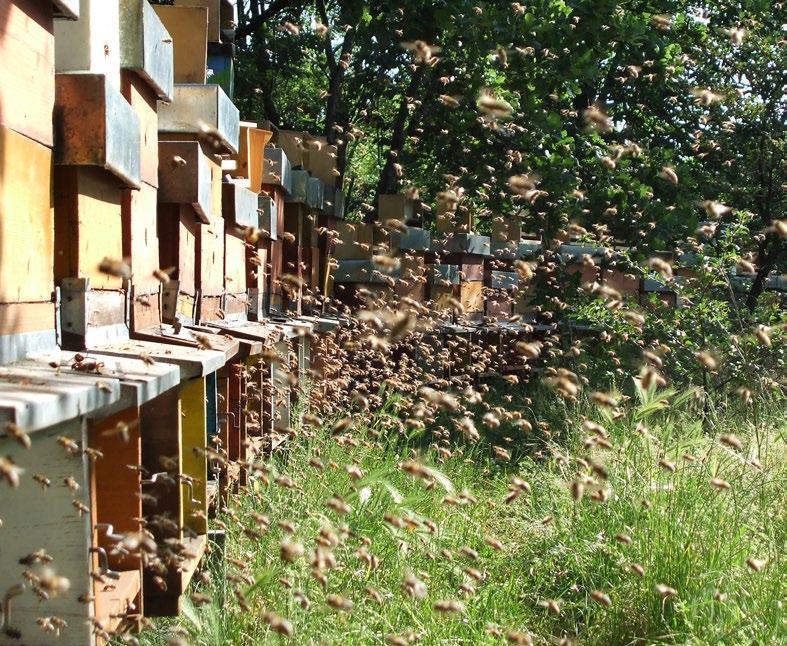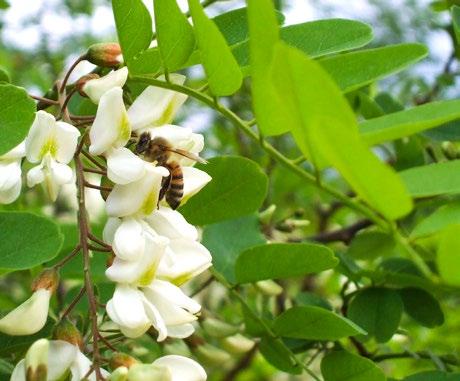
5 minute read
UN MIEL E DA PRIMATO
from number 1
C’è un solo posto al mondo dove si possono trovare alberi di Ciliegio Canino con profumi così speciali e fioriture così lunghe. E c’è un solo posto al mondo dove le api possono raccogliere il nettare del Ciliegio Canino per dieci, dodici, finanche quindici giorni. Ed è sempre uno solo il posto al mondo dove il miele del Ciliegio Canino non è un vuoto miraggio ma un prodotto vero, che puoi toccare, annusare, assaporare, godere. E questo posto è il Carso Triestino, dove il Ciliegio di Santa Lucia, come viene comunemente chiamata questa specie selvatica, dai profumi incredibili e irripetibili, ha trovato un habitat ideale. E questa è la storia di come i profumi del Ciliegio Canino del Carso diventano miele.
Sul Carso otto milioni di voli per vivere un’emozione
Advertisement
— On the Karst eight million flights to live a passion
There is only one place in the whole world where long-blooming mahaleb cheery trees grow, filling the air with their peculiar scent. It is the only place where bees can collect mahaleb cherry nectar for days, even weeks. It is the place where mahaleb cherry honey ceased to be a figment of imagination and became a real product you can touch, smell, taste, and enjoy. This place is the Karst Plateau surrounding the city of Trieste, where St Lucie cherry trees, as they are commonly known, have found their ideal habitat, the perfect ground on which to grow and spread their unique scent. This is the story of how the scent of Karst mahaleb cherry trees turns into honey.
Alice Fabi
Ho cominciato 33 anni fa con due arnie, senza capire una mazza e prendendo un gran bidone. Trecentocinquantamila lire. Ho comprato una famiglia di api per ottantamila lire. Ho comprato un libro, l’ho letto, l’ho riletto. È stato di grande aiuto dopo la terza volta che l’ho letto. I libri ti danno le basi ma poi bisogna capire, anche sbagliare. Personalmente ho imparato tanto dagli errori. E comunque prima bisogna capire la natura, poi bisogna capire le api.”
È impossibile non rimanere affascinati da Fausto Settimi. Questione di estetica e intelligenza. Una lunga, curatissima barba bianca e un cappello a tesa larga incorniciano un viso senza tempo. Estetica. Le parole misurate, senza false illusioni, dritte all’essenza delle cose, colpiscono come verità ovvie. Intelligenza. Fausto si siede, ti guarda negli occhi con il fare di chi vuole sapere “cosa vuoi da me?” ma è chiaro da subito che non serviranno molte domande. La storia del suo miele comincia senza bisogno che noi si dica nulla.
Il miele di Marasca (ma “Marasca” in realtà è un nome improprio) di Settimi & Zaini riscopre una tradizione e parla di una diversa metodologia del fare le cose, interpretando al meglio il legame con il territorio Carsico. Un territorio senza confini secondo Fausto, definito dalla sua geologia. Stessa terra abitata dallo stesso popolo. Parlando con gli anziani di Trebiciano dove si trova la sua azienda, riscopre il Ciliegio Canino o ciliegio di Santa Lucia, “Reselijka” in Sloveno. Un arbusto che in quest’area è sempre stato molto comune grazie a radici che penetrano in profondità nella roccia carsica, trovando l’acqua che in superficie scarseggia. A primavera è tra le prime piante ad andare in fioritura ma capire quando è un pò una scommessa legata al clima. L’apicoltore ogni anno deve quindi decidere quando preparare le api all’impollinazione. “Il miele non lo fa l’apicoltore, sono le api che raccolgono nettare e polline.” In questa affermazione si racchiude molto della filosofia di Fausto Settimi: la natura sa cosa fare, noi non dobbiamo inventarci nè aggiungere nulla, si tratta di seguire, per lo più dettare i ritmi e non voler strafare o pretendere produzioni massive.
Per produrre 1 kg di miele, le api visitano dai 7 agli 8 milioni di fiori. Ad ogni volo le api raccolgono solamente 0,30-0,32 mg di nettare di cui il


60-70% è acqua. Lo trasportano all’arnia nella loro sacca melaria dove viene arricchito di enzimi. Qui viene passato di ape in ape fino ad arrivare ad avere un residuo di acqua che è solo del 16%. È a questo punto che le api capiscono che il miele è pronto e, con la cera, sigillano le celle, tutte inclinate di 9 gradi per evitare che il nettare fuoriesca. Se consideriamo che il Ciliegio Canino cresce solo nella zona di Trebiciano e che la fioritura dura 10-12 giorni, è chiaro come il miele di marasca sia un prodotto raro, disponibile soltanto in piccole quantità. Dal gusto unico, espressione diretta del territorio.
Quando Fausto e sua moglie per la prima volta hanno deciso di presentarlo ai concorsi e ad altri apicoltori, inizialmente veniva rifiutato. La triste legge del diverso che fa fatica ad essere accettato. Oggi il miele di Marasca di Settimi & Zaini è pluripremiato, non ultimo nel 2017 come miele migliore d’Italia.
“I started 33 years ago with just two beehives and no clue at all, which is why I got scammed losing 350,000. I bought a bee family for 80,000. I bought a book, I read it, I read it again. The third time was very helpful. Books can teach you the basics, but then you have to try, make mistakes and learn from them. And, in any case, to be able to understand bees first you have to understand nature.”
It is impossible to resist the charm of Fausto Settimi. Aesthetically and intellectually. His long, carefully trimmed white beard and slouch hat frame a timeless face. Aesthetics. His sober words, free of illusions and straight to the point, sound as indisputable truths. Intellect. Fausto sits down and looks you straight in the eye with an expression that seems to be asking “what do you want from me?” soon, however, you realise that there will be no need for questions. The story of his honey will be told without any prompting.
Marasca honey (although “Marasca” is not actually its right name) by Settimi & Zaini tells the story of an ancient tradition and a different way of doing things, strengthening the bound with the Karst territory. According to Fausto, the Karst area has no boundaries and is defined by its geological traits. An unspoiled territory inhabited by an unspoiled people. Talking with the elderly of Trebiciano, where he runs his business, Fausto discovered the local cherry tree, the mahaleb cherry, also known as St Lucie cherry or “Reselijka” in Slovenian. The mahaleb cherry has always been quite common in this area, where its strong roots penetrate deeply into the Karst rocky ground to reach water too scarce above ground. It is among the earliest bloomers in Spring, although the exact blooming time ultimately depends on the current weather conditions. Every year, therefore, beekeepers have to choose very carefully when to prepare their bees for pollination. “It is bees, not beekeepers, that make honey, by collecting nectar and pollen.” This sentence summarises the very core of Fausto Settimi’s thinking: nature knows what to do, there is no need for human interventions; one only needs to follow nature’s course, monitoring its rhythms without overdoing it or trying to obtain massive production.
For each kilogram of honey bees need to visit 7 to 8 millions of flowers. With each flight they collect 0.30-0.32 mg of nectar, of which 60-70% is water. They carry it in their crop, or honey stomach, and bring it all the way back to the hive, where it is stored in honeycombs and enriched with enzymes. It is then passed from bee to bee for digestion and regurgitation until its water residue is no more than 16%. At this point honey reaches storage quality, and bees cap the honey cells with wax to seal them. Cells have a 9-degree inclination to avoid spilling. Since mahaleb cherries grow only in the area of Trebiciano and their blooming lasts only 10 to 12 days, Marasca honey is a very rare product and is only sold in small quantities. Its taste is unique and brings together all the characteristics of its territory.

When Fausto and his wife started to present their honey at public contests, they found only rejection. Sad but true, what is different is never easily accepted. Today Settimi & Zaini Marasca Honey is a renowned, award-winning product, named best Italian honey in 2017.






